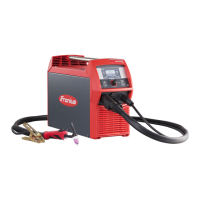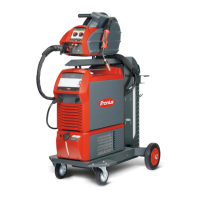12
Noise emission
values
Danger from toxic
gases and va-
pours
Protective clothing refers to a variety of different items. Operators should:
- protect eyes and face from UV rays, heat and sparks using a protective
visor and regulation filter.
- wear regulation protective goggles with side protection behind the protec-
tive visor.
- wear stout footwear that provides insulation even in wet conditions.
- protect the hands with suitable gloves (electrically insulated and providing
protection against heat).
- wear ear protection to reduce the harmful effects of noise and to prevent
injury.
Keep all persons, especially children, out of the working area while any devic-
es are in operation or welding is in progress. If, however, there are people in
the vicinity,
- make them aware of all the dangers (risk of dazzling by the arc, injury
from flying sparks, harmful welding fumes, noise, possible risks from
mains current and welding current, etc.),
- provide suitable protective equipment or
- erect suitable safety screens/curtains.
The device generates a maximum sound power level of <80 dB(A) (ref. 1pW)
when idling and in the cooling phase following operation at the maximum per-
missible operating point under maximum rated load conditions according to
EN 60974-1.
It is not possible to provide a workplace-related emission value during welding
(or cutting) as this is influenced by both the process and the environment. All
manner of different welding parameters come into play, including the welding
process (MIG/MAG, TIG welding), the type of power selected (DC or AC), the
power range, the type of weld metal, the resonance characteristics of the
workpiece, the workplace environment, etc.
The fumes produced during welding contain harmful gases and vapours.
Welding fumes contain substances that may, under certain circumstances,
cause birth defects or cancer.
Keep your face away from welding fumes and gases.
Fumes and hazardous gases
- must not be breathed in
- must be extracted from the working area using appropriate methods.
Ensure an adequate supply of fresh air with a ventilation rate of at least 20 m³/
hour.
Otherwise, a protective mask with an air supply must be worn.
Close the shielding gas cylinder valve or main gas supply if no welding is tak-
ing place.
If there is any doubt about whether the extraction capacity is sufficient, the
measured toxic emission values should be compared with the permissible limit
values.
Amongst others, the following components are responsible for the degree of
toxicity of welding fumes:
- Metals used for the workpiece
- Electrodes
- Coatings
- Cleaners, degreasers, etc.

